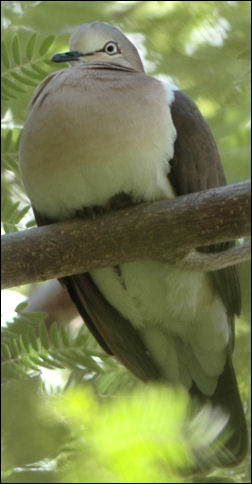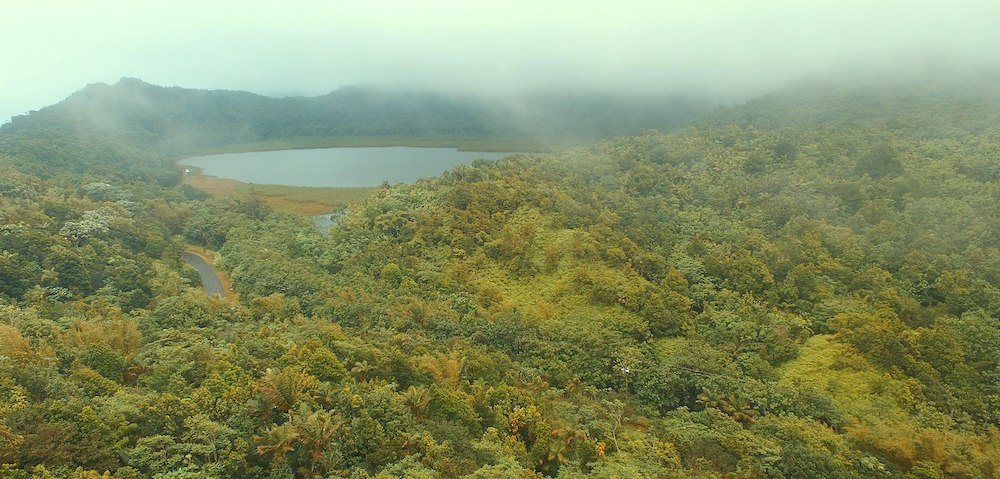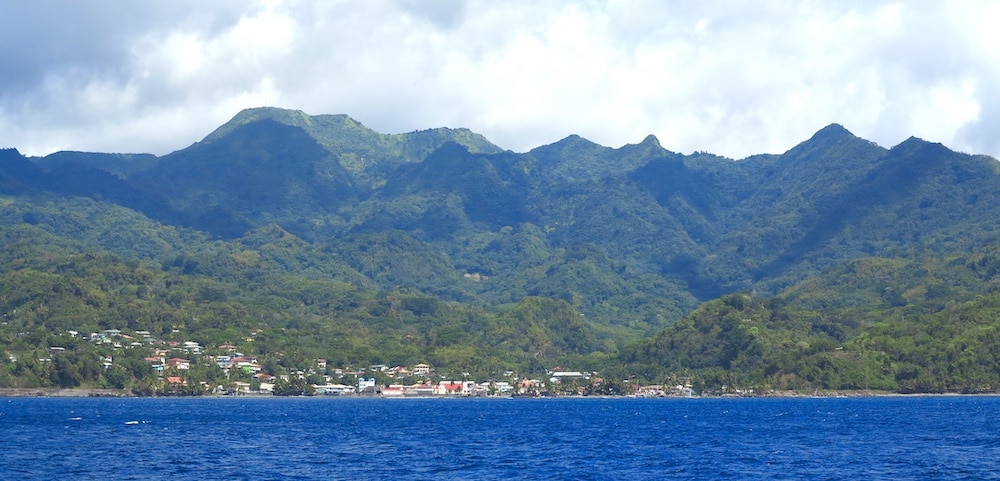Grenada

Grenada is an island country of the West Indies in the eastern Caribbean Sea. The southernmost of the Windward Islands, Grenada is directly south of Saint Vincent and the Grenadines and about 160 km (100 miles) north of Trinidad and the South American mainland. The country consists of the island of Grenada itself, two smaller islands, Carriacou and Petite Martinique, and several small islands which lie to the north of the main island and are a part of the Grenadines group. It covers just under 350 square kilometres (135 square miles), with an estimated population of around 127,000 people, about 34,000 of whom live in its capital and largest settlement, St. George’s. Grenada is also known as the ‘Island of Spice’ due to its production of nutmeg and mace crops.
Grenada is of volcanic origin, as evident in its soil, mountainous interior, and several explosion craters, including Lake Antoine, Grand Etang Lake, and Levera Pond. Grenada’s highest point is Mount St. Catherine, rising to 840 m above sea level. Other major mountains include Mount Granby and South East Mountain. Several small rivers with waterfalls flow into the sea from these mountains. The coastline contains several bays, most notably on the southern coast, split into numerous thin peninsulas. Grenada is home to four ecoregions: Windward Islands moist forests, Leeward Islands dry forests, Windward Islands dry forests, and Windward Islands xeric scrub.

Grand Etang Lake – ©Андрей Бобровский CC BY 3.0 via Wikimedia Commons
Birding Grenada
Grenada has native opossums, armadillos, and introduced mona monkeys and mongooses are common. It also boasts a rich avifauna of 184 bird species, with one endemic (Grenada dove), six introduced, and 116 rare or accidental. It is an island nation of tropical lush green vegetation. Bird Watching is always rewarding to the visitor who goes the extra mile. Being volcanic in geological formation, its rich soils provide fertility for diverse vegetation thus creating a blend of natural and enhanced foliage to the benefit of human and animal population. Many visitors are amazed at the greenery of the vegetation and the natural beauty of the landscape in general. Wildlife is not as diverse as some other Caribbean islands, but there are great and rewarding opportunity to see some unique plant and animal species.
Grenada has recorded total of over 180 species of birds including numerous migratory species and many vagrants. The bird population comprises of terrestrial, wetland /shore and sea birds species. There are a few endemic species or sub-species such as the Grenada Dove Liptotilla wellsi and a race of Hook-billed Kite Condroherux uncinatus mirus. Other Regional endemics include Grenada Flycatcher, Lesser Antillean Tanager, Lesser Antillean Bullfinch and Yellow-bellied Elenia. Because of the location close to the South American mainland there are occasional migrants from the south such as humming birds, hawks and others in transit during migration. Some of the natural habitats for bird life include wetlands; lakes, grasslands/savannahs, Rainforest and numerous beaches and coastlines. The Grenadines islands to the North is a haven for seabirds.

Mount Saint Catherine – ©Tranquilometro CC BY-SA 4.0 via Wikimedia Commons
The climate is tropical: hot and humid in the dry season and cooled by the moderate rainfall in the rainy season. Temperatures generally range from 22 °C to 32 °C and are rarely below 18 °C.
Birds can be seen almost everywhere on the island and there is a good road network and getting around is generally easy. Road maps and guides to the island are always available at hotels and at the airport. Wherever you choose to stay, you can travel around the island in a day and have a wonderful bird watching trip although spending at least three days will give the best experience. Most people on the island are not very enthusiastic about birds and the average person will provide only basic information on just the commonly seen species. Local bird guides are very few and generally not professional.
One very rewarding experience for the avid birdwatcher is a visit to Mt. Hartman National Park. Be prepared to be up early in the morning to start a day bird watching.
-
Mount Hartman Dove Sanctuary
InformationSatellite ViewMt. Hartman National Park and Bird sanctuary is one of the two habitats for the Grenada Dove, an endemic with a population of just under 200 and very much threatened with depleting habitat. A visiting experience would require fitness, proper equipment and keen eyes. Be prepared to wear protective clothing and tough boots for thorny vegetation at times.
-
Number of bird species: 204
(As at June 2024)National Bird: Grenada Dove Leptotila wellsi
Number of endemics: 1
Grenada Dove Leptotila wellsiOne species is shared only with St Vincent: Grenada Flycatcher Myiarchus nugator
Number of endemics: Endemic Subspecies:
The Grenada Tanager nominate race is endemic to Grenada as is the Kite and the House Wren races, the latter of which is rumoured to be ripe for splitting.Grenada Hook-billed Kite Chondrohierax uncinatus mirus
Grenada Tanager Stilpnia cucullata cucullata
Grenada Wren Troglodytes aedon grenadensis
-
Caribbean Bird Trail
PDF ChecklistGrenada is known for many things—Grande Anse Beach, spices, its underwater sculpture park. Less known is Grenada’s rich natural history and incredible bird life. More than 160 species of birds have been recorded on Grenada! This includes birds that can only be found on this island: the Grenada Dove and Grenada Hook-billed Kite. Other special birds include Grenada Flycatcher, Antillean Crested Hummingbird, Lesser Antillean Tanager, and Lesser Antillean Bullfinch— found only in the Lesser Antilles. -
Avibase
PDF ChecklistThis checklist includes all bird species found in Grenada , based on the best information available at this time. It is based on a wide variety of sources that I collated over many years. I am pleased to offer these checklists as a service to birdwatchers. If you find any error, please do not hesitate to report them. -
DiBird
Annotated ListBirds in Grenada -
Wikipedia
Annotated ListThis is a list of the bird species recorded in Grenada. The avifauna of Grenada included a total of 197 species according to Bird Checklists of the World as of July 2022. -
eBird
PDF Checklist180 species (+27 other taxa) - Year-round, All years
-
The Birds of St Vincent, the Grenadines and Grenada
| An Annotated Checklist | By James W Wiley | BOC | 2021 | Paperback | 384 pages, 32 plates with 78 colour photos and 1 colour map | ISBN: 9780952288688 Buy this book from NHBS.com -
The Birds of the West Indies
| By Guy M Kirwan, Anthony Levesque, Mark W Oberle & Christopher J Sharpe | Lynx Edicions | 2019 | 400 pages, 1600+ colour illustrations, 650+ colour distribution maps | ISBN: 9788416728176 Buy this book from NHBS.com

Birds of the Caribbean
AndroidBirds of the Caribbean. It includes the birds of Grenada... Birds of the Caribbean. It includes the birds of Grenada...
Birds of the West Indies
Apple iOS |Explore the vibrant Caribbean islands with Birds of the West Indies – your pocket guide to Caribbean birdwatching! Explore the vibrant Caribbean islands with Birds of the West Indies – your pocket guide to Caribbean birdwatching!Organisations-
Birds Caribbean
WebsiteBirdsCaribbean is a vibrant international network of members and partners committed to conserving Caribbean birds and their habitats in the insular Caribbean (including Bermuda, the Bahamas and all islands within the Caribbean basin).
Reserves-
BS Mount Hartman Dove Sanctuary
WebpageSatellite ViewNear scenic Woburn Bay and Secret Harbor lies the protected dry cactus scrub ecosystem supporting the endangered endemic Grenada Dove (only found in Grenada - Lepotila wellsi). The savanna-like flat grassland areas were previously used for grazing livestock and agricultural products. The dove is currently considered one of the most endangered birds in the world; less than 100 of the species remain. Conservation of the dove, ecological research, and education are the primary management objectives of the National Park. -
NP Grand Etang
InformationSatellite ViewA series of trails have been developed which are well worth the effort for the beautiful forest and views, but can be muddy and slippery after rain… -
NP Levera
InformationSatellite ViewEstablished in 1992, this 450-acre park holds an unbeaten reputation as Grenada’s most scenic and spectacular coastal area. Its picture-perfect beach is quite popular on weekends, and its pond is one of the most important wildlife habitats on the island. Unfortunately, the government made a failed attempt at developing a luxury resort here, and ownership of some of the land is currently (2018) in flux. -
NR La Sagesse Nature Centre
InformationSatellite ViewThis quiet mangrove estuary along the southern coast is one of the best bird-watching locales on Grenada. The area contains some 22 hectares, representative of the dry coastal belt with dry evergreen woodland and cactus scrub. In addition to the estuary, La Sagesse includes three fine beaches edged with palm trees, a very good coral reef for snorkeling, a pristine example of dry thorn scrub and cactus woodland, and a salt pond. The pond attracts an abundance of different species. -
NR Lake Antoine
InformationSatellite ViewThe lake's perimeter trail, a beautiful walk in itself, is another of Grenada's excellent attractions for bird watchers. From the top of a hill you'll have a fine overview of this perfectly shaped crater. Assuming the access path is in decent shape, take the track down and walk the perimeter of the shallow crater lake, which covers 16 acres. Among the species frequently sighted are the Snail Kite, the Fulvous Whistling Duck, Large- Billed Seed Finch, Gray Kingbird, and Limpkin.
Guides & Tour Operators-
Caribbean Horizons
Tour OperatorGo in search of the endangered Grenada Dove and other resident and migratory birds, on this fascinating Grenada Bird Watching Tour by Caribbean Horizons.
Trip Reports-
2017 [06 June] - Mark Van Beirs - Lesser Antilles & Trinidad
PDF ReportAntigua, Barbuda, Montserrat, Dominica, Guadeloupe, Martinique, Santa Lucia, Saint Vincent, Barbados and Grenada were the ten islands we visited on our recent Lesser Antilles tour. Some are independent countries in their own right, while others are Overseas Territories... -
2023 [06 June] -
PDF ReportAlong the 1.5 km walk to Mt. Hartman there were multiple singing Grenada Wren, the first target of the trip! When I arrived at the visitor center, I heard a Grenada Dove immediately, but it was deep in the woods behind a fence. So I took the first trail I saw which was behind the bird identification sign (before/west of the visitor center) which took me to a viewing platform. I heard another Grenada Dove from here. Then I went back out and took the trail at the SE corner of the visitor center (this definitely seems to be the entrance to the main trail system). The trails aren’t well-maintained and a few times I wasn’t even sure I was on a trail, but it seemed to work well enough. I heard and saw multiple Grenada Doves, Wrens, and Flycatchers on this trail. I eventually popped out at a series of clearings (visible on Google Maps satellite view) that seem to host cattle from time to time based on the scat. The view from this clearing allowed me to see the sky and I locked on to a pair of Hook-billed Kites! -
2024 [03 March] - Peg Abbott
PDF ReportA grand adventure designed to showcase the endemic species of 10 Lesser Antillean Islands in 14 days -
Places to Stay-
Grenada Hotels
AccommodationA useful list of hotels and guest houses. -
MoonFish Beach Houses
AccommodationMoonFish is an ideal base for birdwatching and nature walks being close to Levera National Park (walking distance) and Lake Antoine National Park (10 minute drive), as well as Telescope and the abandoned airfield at Pearls (20 minute drive). Grenada boasts between 150-170 species of birds to discover, 70% of which are neotropical migrants - especially the water birds and seabirds -
Treetops Villa Guest House
AccommodationFrom our veranda, birders can watch Magnificent Frigate Birds hovering above and hawks soaring at eye level, taking advantage of the stiff sea breezes. Treetops Villa Guest House is in a secluded woodland setting close to numerous forest hiking trails. We are a 25-minute drive from Levera National Park.
Other Links-
BirdSleuth Grenada
Facebook PagePromotes student environmental stewardship by establishing a network of conservation educators and teachers for the plight of local and migratory birds. -
Caribbean Birding Trail
WebsiteLocated at the southern end of the Lesser Antilles chain of islands, Grenada is a tri-island state comprised of Grenada, Carriacou and Petite Martinique. Grenada is considered the mainland as it is the biggest geographically of the three islands and holds the largest population of around 90,000. It is 312 sq km and has 121 km of coastline.
Fatbirder - linking birders worldwide... Wildlife Travellers see our sister site: WAND
Skip to content
